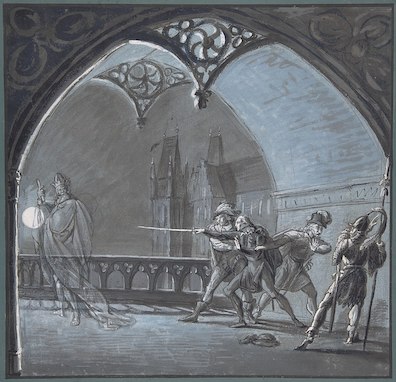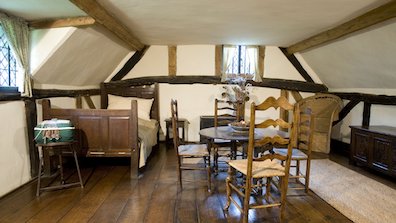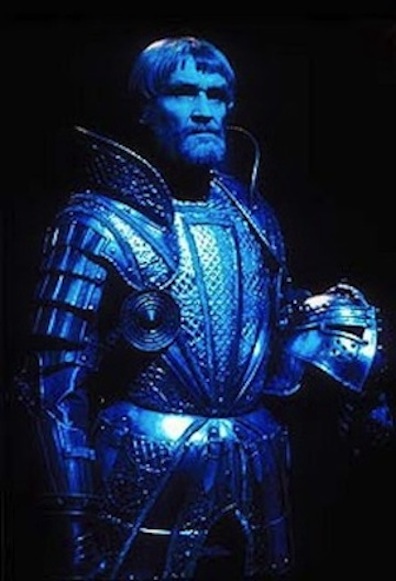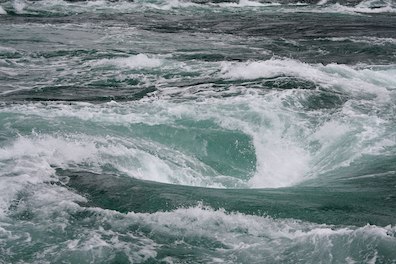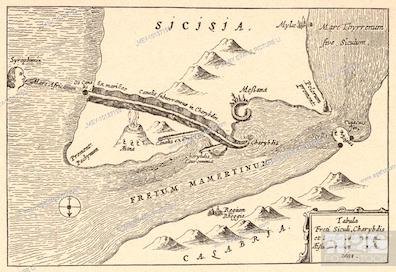To Eglinton's implication that he is trivializing Hamlet
by treating it as a ghost story, Stephen replies that
spectrality can be literal or metaphorical: "What is a
ghost? Stephen said with tingling energy. One who has faded
into impalpability through death, through absence, through
change of manners. Elizabethan London lay as far from
Stratford as corrupt Paris lies from virgin Dublin. Who is
the ghost from limbo patrum, returning to the world
that has forgotten him? Who is King Hamlet?" The answer
to his rhetorical questions is William Shakespeare: "the
player is Shakespeare who has studied Hamlet all the
years of his life which were not vanity in order to play the
part of the spectre."
Limbus Patrum, the Limbo of the Fathers, is the place
in the infernal afterlife thought to have held ancient
patriarchs, matriarchs, and other virtuous Hebrews who died
before the coming of Christ, and who were liberated in the
so-called Harrowing of Hell after Christ's resurrection.
Shakespeare uses the term as a joking name for jail in Henry
VIII, when the jailkeeper says of an unruly collection
of youths, "I have some of 'em in Limbo Patrum, and
there they are like to dance these three days" (5.3.63-65).
Stephen uses the same phrase as a joking name for what the
ghost calls "my prison-house," which sounds very much like Purgatory.
The king is confined in this fiery otherworld by day but
returns to visit the living at night. Similarly, Stephen
suggests, William Shakespeare left his family in Stratford to
become a player in London but, like an unquiet spirit haunting
the living, he thought every day about the people he left
behind, turning them into fictional characters.
Later in the talk, Stephen reiterates his analogy between
literal ghosts and metaphorical ones, saying that Shakespeare
became "a ghost by absence, and in the vesture of buried
Denmark, a ghost by death, speaking his own words to his
own son's name (had Hamnet Shakespeare lived he would have
been prince Hamlet's twin)." Like the ghost in the play, what
the playwright wanted to talk about was the unfaithfulness of
his wife. In a long paragraph a bit later, Stephen maintains
that Anne Hathaway (or Ann, as she is called in Scylla)
was the inspiration for female characters like Venus in Venus
and Adonis, Kate in The Taming of the Shrew, and
Cleopatra in Antony and Cleopatra––powerful, sexually
cunning women who struggle for dominance in their
relationships with men. Stephen sees them as barely
fictionalized versions of the "boldfaced Stratford wench" who
"tumbles in a cornfield a lover younger than herself."
When Lyster the librarian asks to hear more about Anne ("Is
it your view, then, that she was not faithful to the poet?"),
Stephen tries out an abstract name for the ghostly state of
mind: "— Where there is a reconciliation, Stephen
said, there must have been first a sundering." Later
still, when Lyster remarks that the late romances breathe "the
spirit of reconciliation," Stephen repeats himself:
"— There can be no reconciliation, Stephen said, if there
has not been a sundering. / Said that." In this second
iteration of the sentence, Shakespeare's marital estrangement
is linked with the development of his writing career. Hamlet,
with its ghost complaining about sexual betrayal, initiated a
period of great tragic writing in which Shakespeare directly
confronted his misery and explored a dark view of humanity. In
the romances written at the end of his career he found, if not
complete "reconciliation" with Anne, then at least a measure
of acceptance, and he wrote happy endings for his tragicomic
plays.
This condition that Stephen calls "sundering" arose from
loving someone and losing her, but it also involved self-loss:
Belief in himself has been untimely killed. He
was overborne in a cornfield first (ryefield, I should say)
and he will never be a victor in his own eyes after nor play
victoriously the game of laugh and lie down. Assumed
dongiovannism will not save him. No later undoing will undo
the first undoing. The tusk of the boar has wounded him there
where love lies ableeding. If the shrew is worsted yet there
remains to her woman's invisible weapon. There is, I feel
in the words, some goad of the flesh driving him into a new
passion, a darker shadow of the first, darkening even his
own understanding of himself. A like fate awaits him
and the two rages commingle in a whirlpool.
Becoming a conquering Don Juan in the licentious houses of
London could not erase Shakespeare's feeling of being unmanned.
He needed to confront the loss by writing about it, and as he
did so his views on life became more skeptical, disillusioned,
and misanthropic. Calling this dark place a "whirlpool" suggests
that the Homeric motif of the chapter may apply to Stephen's
language of ghostly sundering. Scylla, here, would be the naive
everyday world of confident human striving, Charybdis the
cynical void that awaits anyone who loses faith in that life.
Shakespeare fell into this bottomless gulf and struggled to
climb out of it.
In Shakespeare's case (a unique one), self-loss was bound up
with a genius for inhabiting the thoughts and words of other
people. Bringing characters into vivid existence out of thin
air, the playwright became insubstantial himself: "
He is a
ghost, a shadow now, the wind by Elsinore's rocks or what you
will, the sea's voice, a voice heard only in the heart of him
who is the substance of his shadow, the son consubstantial
with the father." Living apart from his actual loved ones
in Stratford, sundered from those sustaining physical
connections, Shakespeare became a ghostly spirit, and like the
unearthly Father sending a corporeal Son to earth he made new
dramatic equivalents of the people he loved.
When Stephen returns, later in the chapter, to this idea of
Shakespeare as a ghostly Father begetting a
consubstantial
Son, he says that the church was "
founded, like the
world, macro and microcosm, upon the void. Upon
incertitude, upon unlikelihood." There is an implicit reference
here to Christ's pun on Peter as a rock (
petros): "Upon
this rock I found my church." Seen in terms of Joyce's Homeric
framework, that would be the rock of Scylla, the symbol of
material existence and quotidian reality. Stephen suggests, to
the contrary, that the cosmos, the human psyche, and
Shakespeare's dramatic creations are founded upon the void, the
whirlpool, the vast disembodied potentiality of the mind. The
world that, to most people, most of the time, feels real and
substantial is an outward manifestation of something shrouded in
ghostly incertitude.
Many of Stephen's words suggest that, in formulating a broadly
encompassing account of the bard's dramatic career and
imaginative powers, he is laying out a roadmap for his own
eventual production of a great literary work. When he asks "What
is a ghost?" he speaks "
with tingling energy," as if he
identifies with or aspires to the playwright's eerie condition.
When he goes on to say that "
Elizabethan London lay as far
from Stratford as corrupt Paris lies from virgin Dublin,"
he maps his own artistic aspirations onto the example of
Shakespeare by reflecting that he too aspires to escape a
cultural backwater and enter the life of a great city. (Gifford
notes that "it took as long to travel from Stratford to London
in Elizabethan times as it took to travel from Dublin to Paris
in the early twentieth century." Slote, Mamigonian, and Turner
follow suit, getting highly specific about the distances and
times involved. But surely such literalism is beside the main
point, which is that both artists were worlds away from their
parochial home towns when they wrote.)
At the end of
A Portrait of the Artist Stephen had
proclaimed his determination to leave Dublin, move to Paris, and
"forge in the smithy of my soul the uncreated conscience of my
race." By June 1904 that flight has turned out to be a youthful
folly, but in late 1904 Joyce tried again, leaving for the
continent as an adult with a sexual partner, and like
Shakespeare he wrote about his home from afar. Various
statements in part 5 of
A Portrait anticipate the talk
in the library, chief among them Stephen's claim that drama, the
most highly achieved form of literature, results from the writer
withdrawing entirely from his fictional world: "The artist, like
the God of the creation, remains within or behind or beyond or
above his handiwork, invisible, refined out of existence,
indifferent, paring his fingernails." In
Scylla and
Charybdis this invisible, godlike, sublimely impersonal
artist is reimagined as a ghost.
As a coda to this long discussion it may be worth calling to
mind the remarkably similar ideas that Jorge Luis Borges
expressed in his memorable short essay
Everything and
Nothing. Borges admired the "cathedral-like grandeur" of
Ulysses
(
Joyce's Ulysses, 1925), and though he confessed to never
reading all of it he said that he read three episodes
repeatedly:
Circe, Ithaca, and "the dialogue on
Shakespeare" (
A Fragment on Joyce, 1941). It seems likely
that his fanciful portrait of Shakespeare as "no one" was
inspired by Joyce's fancy that he was "a ghost":
There was no one in him: behind his face...there was
nothing but a bit of cold, a dream not dreamed by anyone....
he considered he might find what he sought in carrying out one
of the elemental rites of humanity, and so he let himself be
initiated by Anne Hathaway in the long siesta hour of an
afternoon in June. In his twenties, he went to London.
Instinctively, he had already trained himself in the habit of
pretending he was someone, so it should not be discovered that
he was no one. In London, he found the profession to which he
had been predestined, that of actor: someone who, on a stage,
plays at being someone else, before a concourse of people who
pretend to take him for that other one. His histrionic work
taught him a singular satisfaction, perhaps the first he had
ever known. And yet, once the last line of verse had been
acclaimed and the last dead man dragged off stage, he tasted
the hateful taste of unreality. He would leave off being
Ferrex or Tamburlaine and become no one again. Thus beset, he
took to imagining other heroes and other tragic tales. And so,
while his body complied with its bodily destiny in London
bawdyhouses and taverns, the soul inhabiting that body was
Caesar unheeding the augur’s warning, and Juliet detesting the
lark, and Macbeth talking on the heath with the witches who
are also the Fates. No one was ever so many men as that
man....
He persisted in this directed
hallucination for twenty years. But one morning he was
overcome by a surfeit and horror... Before a week was out he
had gone back to his native village...
History adds that before or after his
death he found himself facing God and said: I who have
been so many men in vain, want to be one man, myself alone.
From out of a whirlwind the voice of God replied: I am
not, either. I dreamed the world the way you dreamed your
work, my Shakespeare: one of the forms of my dream was you,
who, like me, are many and no one.
(trans. Anthony
Kerrigan)
